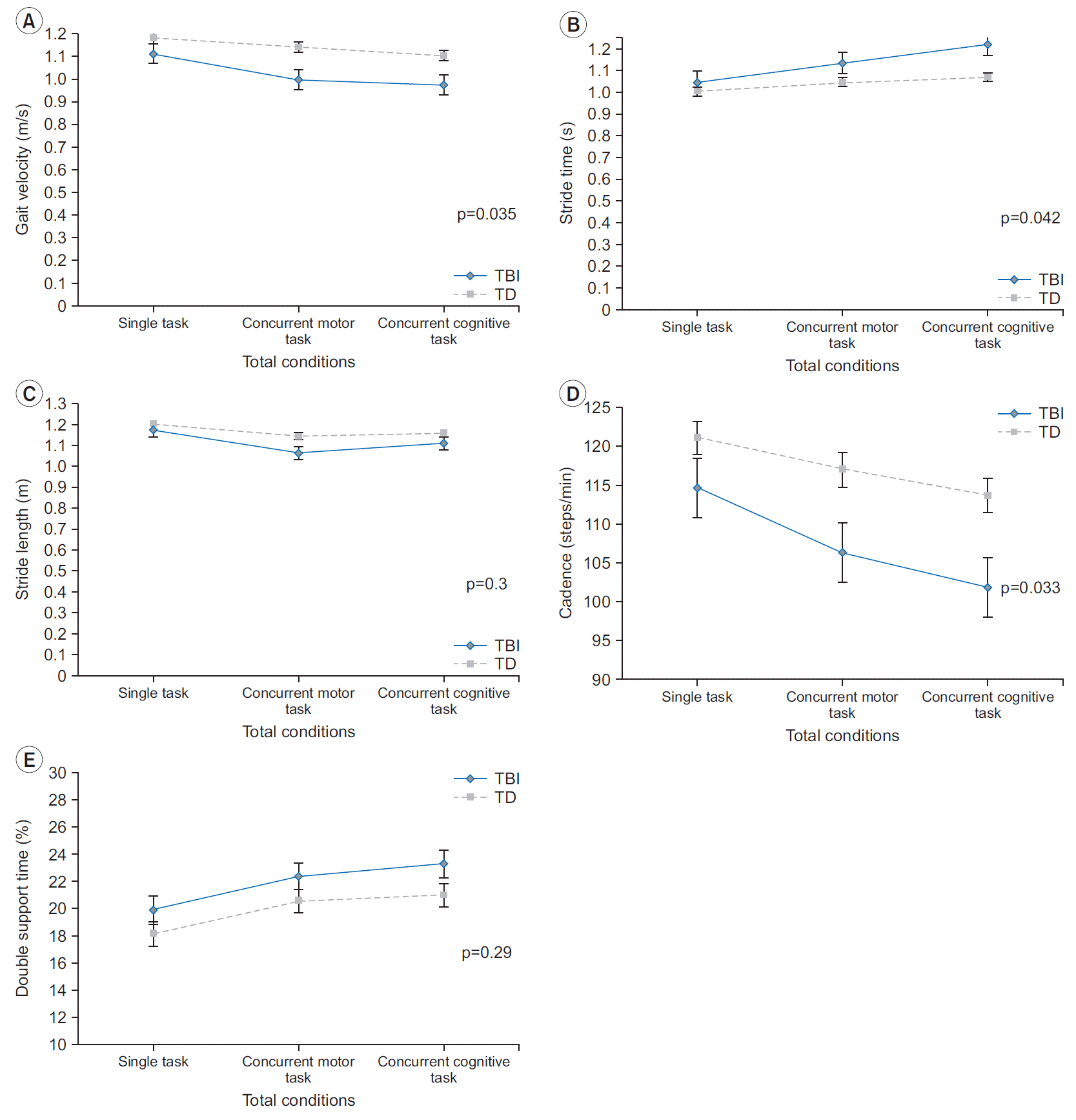1. Wetherington CE, Hooper SR, Keenan HT, Nocera M, Runyan D. Parent ratings of behavioral functioning after traumatic brain injury in very young children. J Pediatr Psychol. 2010; 35:662–71.

2. Anderson V, Catroppa C. Recovery of executive skills following paediatric traumatic brain injury (TBI): a 2 year follow-up. Brain Inj. 2005; 19:459–70.

3. Anderson V, Godfrey C, Rosenfeld JV, Catroppa C. 10 years outcome from childhood traumatic brain injury. Int J Dev Neurosci. 2012; 30:217–24.

4. McInnes K, Friesen CL, MacKenzie DE, Westwood DA, Boe SG. Mild Traumatic Brain Injury (mTBI) and chronic cognitive impairment: a scoping review. PLoS One. 2017; 12:e0174847.

5. Kohler MJ, Hendrickx MD, Powell-Jones A, Bryan-Hancock C. A systematic review of cognitive functioning after traumatic brain injury in individuals aged 10-30 years. Cogn Behav Neurol. 2020; 33:233–52.

6. Beretta E, Cimolin V, Piccinini L, Carla Turconi A, Galbiati S, Crivellini M, et al. Assessment of gait recovery in children after traumatic brain injury. Brain Inj. 2009; 23:751–9.

7. Katz-Leurer M, Rotem H, Lewitus H, Keren O, Meyer S. Relationship between balance abilities and gait characteristics in children with post-traumatic brain injury. Brain Inj. 2008; 22:153–9.

8. Catena RD, van Donkelaar P, Chou LS. Cognitive task effects on gait stability following concussion. Exp Brain Res. 2007; 176:23–31.

9. Sosnoff JJ, Broglio SP, Ferrara MS. Cognitive and motor function are associated following mild traumatic brain injury. Exp Brain Res. 2008; 187:563–71.

10. Limond J, Dorris L, McMillan TM. Quality of life in children with acquired brain injury: parent perspectives 1-5 years after injury. Brain Inj. 2009; 23:617–22.

11. Souza LM, Braga LW, Filho GN, Dellatolas G. Quality-of-life: child and parent perspectives following severe traumatic brain injury. Dev Neurorehabil. 2007; 10:35–47.

12. Rossi C, Sullivan SJ. Motor fitness in children and adolescents with traumatic brain injury. Arch Phys Med Rehabil. 1996; 77:1062–5.

13. Woollacott M, Shumway-Cook A. Attention and the control of posture and gait: a review of an emerging area of research. Gait Posture. 2002; 16:1–14.

14. Catena RD, van Donkelaar P, Chou LS. The effects of attention capacity on dynamic balance control following concussion. J Neuroeng Rehabil. 2011; 8:8.

15. Anderson V, Eren S, Dob R, Le Brocque R, Iselin G, Davern TJ, et al. Early attention impairment and recovery profiles after childhood traumatic brain injury. J Head Trauma Rehabil. 2012; 27:199–209.

16. Pashler H. Dual-task interference in simple tasks: data and theory. Psychol Bull. 1994; 116:220–44.

17. Katz-Leurer M, Rotem H, Keren O, Meyer S. Effect of concurrent cognitive tasks on gait features among children post-severe traumatic brain injury and typically-developed controls. Brain Inj. 2011; 25:581–6.

18. Abdul Rahman RA, Rafi F, Hanapiah FA, Nikmat AW, Ismail NA, Manaf H. Effect of dual-task conditions on gait performance during Timed Up and Go test in children with traumatic brain injury. Rehabil Res Pract. 2018; 2018:2071726.

19. Gianarris WJ, Golden CJ, Greene L. The Conners’ Parent Rating Scales: a critical review of the literature. Clin Psychol Rev. 2001; 21:1061–93.

20. Poreh A, Miller A, Dines P, Levin J. Decomposition of the Trail Making Test: reliability and validity of a computer assisted method for data collection. Arch Assess Psychol. 2012; 2:57–72.
21. Sanchez-Cubillo I, Perianez JA, Adrover-Roig D, Rodriguez-Sanchez JM, Rios-Lago M, Tirapu J, et al. Construct validity of the Trail Making Test: role of task-switching, working memory, inhibition/interference control, and visuomotor abilities. J Int Neuropsychol Soc. 2009; 15:438–50.

22. Llorente AM, Sines MC, Rozelle JC, Turcich MR, Casatta A. Effects of test administration order on children’s neuropsychological performance: emerging one-word expressive and receptive language skills. Clin Neuropsychol. 2000; 14:162–72.

23. Llorente AM, Voigt RG, Williams J, Frailey JK, Satz P, D’Elia LF. Children’s Color Trails Test 1 & 2: test-retest reliability and factorial validity. Clin Neuropsychol. 2009; 23:645–60.
24. Franjoine MR, Gunther JS, Taylor MJ. Pediatric balance scale: a modified version of the berg balance scale for the school-age child with mild to moderate motor impairment. Pediatr Phys Ther. 2003; 15:114–28.

25. Mancini M, King L, Salarian A, Holmstrom L, McNames J, Horak FB. Mobility lab to assess balance and gait with synchronized body-worn sensors. J Bioeng Biomed Sci. 2011; Suppl 1:007.
26. Cherng RJ, Liang LY, Hwang IS, Chen JY. The effect of a concurrent task on the walking performance of preschool children. Gait Posture. 2007; 26:231–7.

27. Katz-Leurer M, Rotem H, Keren O, Meyer S. The effect of variable gait modes on walking parameters among children post severe traumatic brain injury and typically developed controls. NeuroRehabilitation. 2011; 29:45–51.

28. Katz-Leurer M, Rotem H, Keren O, Meyer S. The relationship between step variability, muscle strength and functional walking performance in children with post-traumatic brain injury. Gait Posture. 2009; 29:154–7.

29. Katz-Leurer M, Rotem H, Keren O, Meyer S. Recreational physical activities among children with a history of severe traumatic brain injury. Brain Inj. 2010; 24:1561–7.

30. Katz-Leurer M, Rotem H, Keren O, Meyer S. Balance abilities and gait characteristics in post-traumatic brain injury, cerebral palsy and typically developed children. Dev Neurorehabil. 2009; 12:100–5.

31. Cherng RJ, Liang LY, Chen YJ, Chen JY. The effects of a motor and a cognitive concurrent task on walking in children with developmental coordination disorder. Gait Posture. 2009; 29:204–7.

32. Huang HJ, Mercer VS, Thorpe DE. Effects of different concurrent cognitive tasks on temporal-distance gait variables in children. Pediatr Phys Ther. 2003; 15:105–13.

33. Huang HJ, Mercer VS. Dual-task methodology: applications in studies of cognitive and motor performance in adults and children. Pediatr Phys Ther. 2001; 13:133–40.

34. Hagmann-von Arx P, Manicolo O, Lemola S, Grob A. Walking in school-aged children in a dual-task paradigm is related to age but not to cognition, motor behavior, injuries, or psychosocial functioning. Front Psychol. 2016; 7:352.

35. Manaf H, Justine M, Goh HT. Effects of attentional loadings on gait performance before turning in stroke survivors. PM R. 2015; 7:1159–66.






 PDF
PDF Citation
Citation Print
Print



 XML Download
XML Download